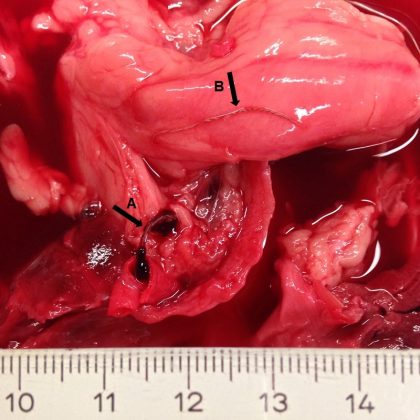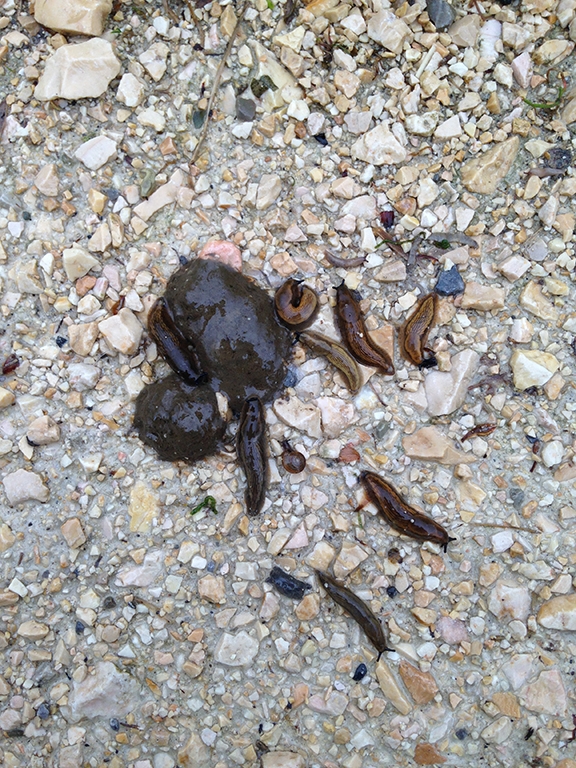Why is it dangerous to walk dogs where foxes live? A parasite on the rise
The latest Paper of the Month for Parasitology is Conquering Switzerland: emergence of Angiostrongylus vasorum over three decades and rapid regional increase in the fox population contrasts with the stable prevalence of lungworms
Did you know that foxes can harbour a heartworm which can cause respiratory problems or bleeding in your dog?

Foxes are widely distributed in the Northern hemisphere, and the populations have drastically increased since the 1990s. A considerable number of foxes moved to cities and now live the urban life, profiting from the great abundance of food sources. Others live in periurban areas where for instance little gardens offer protection and food. Such territories may overlap with recreational areas where dogs are walked.
From the parasitological point of view, foxes host the same parasites as dogs. Among these is the heartworm, called Angiostrongylus vasorum or ‘French heartworm’. This nematode lives in the heart of canids, and their larval stages damage the lung tissues.

Little is known about the impact of this parasite on fox health. However, when dogs get infected, it may have severe consequences such as respiratory distress, unstoppable bleedings in different parts of the body, and even neurological issues. Although discovered in France already in the 19th century, the “French heartworm” spread across Europe only recently. Particularly in the last two decades, veterinarians have diagnosed many more dogs harbouring this parasite than in the past. Is the “French heartworm” on the rise and not French anymore?
In our study, we investigated the infection rate of heartworms and two other lungworms in Swiss foxes. Over six years, we dissected more than 500 foxes in a known endemic area. In the first year, 1 out of 5 foxes were infected with heartworms and by the last year 4 out of 5, thus a four-time increase in only six years! We also determined that the average number of parasites per animal increased each year. This means that infected foxes had more parasites in their hearts, implying higher parasite reproductivity. Interestingly, the increase of the “French heartworm” was very much in contrast to the other two lungworms. Despite comparable life cycles, these were detected at around the same rate each year.
To dig even deeper, we wanted to know how and when the heartworm infection rate in foxes changed in the past. To this aim, we used a test that allows detecting antigens (parasite components) of the French heartworm in blood. We tested almost 4000 fox blood samples from across Switzerland, collected throughout three decades. In the late 1980s and early 1990s, only 2% of foxes tested positive for the French heartworm. At around the turn of the millennium, the numbers of positive foxes had risen to around 30%. By the mid-2010s the infection rate had doubled, 60% of the foxes were infected!
We have proven what parasitologists and veterinarians across Europe had been suspecting for many years: heartworm infection in foxes has increased dramatically in the past two decades. The large number of infected foxes also explains why we are seeing many more infected dogs. What we have observed in Swiss foxes illustrates what happened in the surrounding European countries. It also shows that increasing heartworm occurrence is a continuous, unstoppable trend. Reports of infected dogs are not only more common from known heartworm endemic areas but also from places where it has never been detected before. Why is especially this heartworm so impressively spreading? So far, the reasons remain a mystery.

What can you do to protect your dog from getting infected? Foxes excrete the larval stages and you might think that you are on the safe side by keeping your dog away from foxes or their excretions. But there is a third party involved: slugs and snails. Some of these gastropods like to feed on fox faeces, take up the parasites which then develop to the infectious stages. So, like foxes, if your dog has a taste for escargots it may be at risk. The higher the number of infected foxes, the higher is the infection rate in slugs. Observe the environment when walking your dog: do you see slimy critters, and does your dog eat them?
The paper “Conquering Switzerland: emergence of Angiostrongylus vasorum over three decades and rapid regional increase in the fox population contrasts with the stable prevalence of lungworms” by Nina Gillis-Germitsch, Lucienne Tritten, Daniel Hegglin, Peter Deplazes and Manuela Schnyder, published in Parasitology, is available free for a month.






